Why do food preferences differ from region to region and country to country?
Isn’t it a little weird that food in some countries is as bland as a wet water biscuit, while in other countries a three-alarm chili is considered a pleasant snack?
But the fact is, there really is no accounting for taste; as the saying goes, ‘One man’s meat is another man’s poison’.
Across Europe, from Iceland to Estonia, every country has what is regarded as its national dish. But the question remains; are they really the national dish? And who decides?
While there are no definitive answers (in most countries), there are clear favorites as to which dishes hold the title, or at the very least, could easily represent their country in the Food Olympics.
So, grab your passport, pack your napkin, and get ready to hit the highways and byways of Europe.
Best deals just got better
It’s a great feeling to find best deals. It’s even better to get rewarded in addition to best deals. Redeem rewards to gift cards and cryptocurrency!
What are Europe’s national dishes?
Before we continue on our exploration of national gastronomic treasures — in no particular order — let’s start by saying, we’re going to get it wrong at times. Probably, very very wrong. But isn’t that half the fun of any journey of exploration?
Forks at the ready, let the games begin.
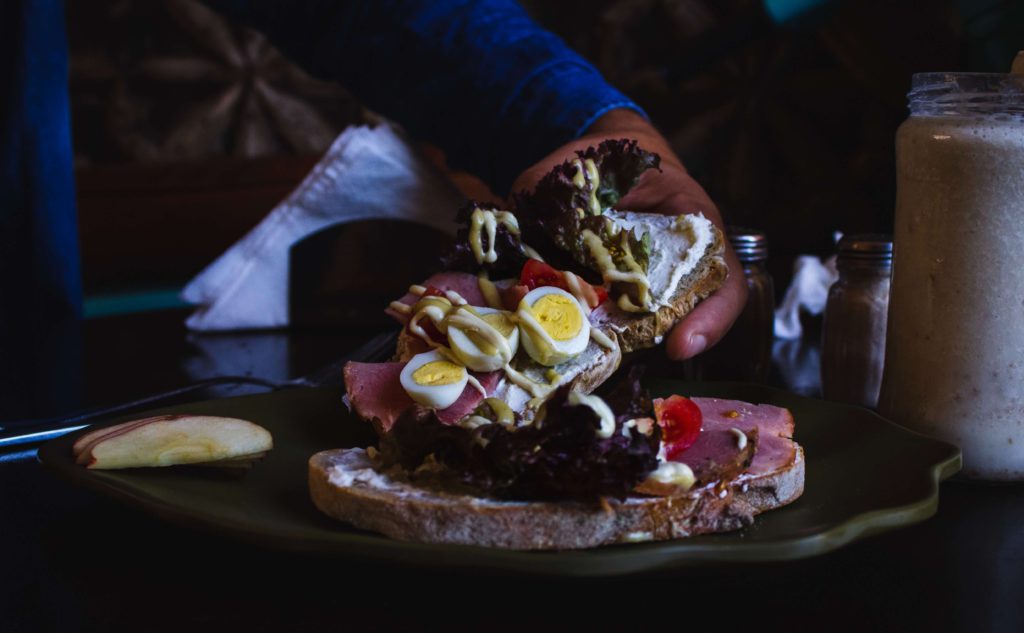
Denmark
Smørrebrød – Think open sandwiches, think delicious rye bread, then think of any combination of toppings that might take your fancy. Roast beef, pickles, boiled eggs, salami, cherry tomatoes, honey-baked ham, pickled herrings, shrimps, all topped with creamy mayo and a sprinkle of fresh salad greens. Oh, and don’t forget the etiquette; always use a knife and fork when eating your Smørrebrød. Velbekomme!
Estonia
Verivorst – If there’s one thing to put a smile on an Estonian’s face in winter, it’s Verivorst. Verivorst is a traditional blood sausage – made with onions, barley, allspice, marjoram, and of course, the most necessary ingredient, blood. Estonians especially adore it served roasted with pork, potatoes, sour cream and topped with sauerkraut — usually as part of their Estonian Christmas celebrations.
Finland
Ruisleipä – That’s rye bread to you and me. In Nordic countries, known for their extreme cold winters, rye bread provides much-needed nutrients. Now, Finns just love the taste of Ruisleipä and you can be sure to find it on every menu, from country inns to fine-dining establishments. (PS – if you’re not a big fan of rye, check out the country’s famous Karelian Pies)
Sweden
Kanelbullar – OK, it would be easy to say meatballs and lingonberries, but if you spend a little time in Sweden these delicious cinnamon rolls will have you coming back for more. This crunchy circle of sweet satisfaction is a national institution. Long live Kanelbullar.
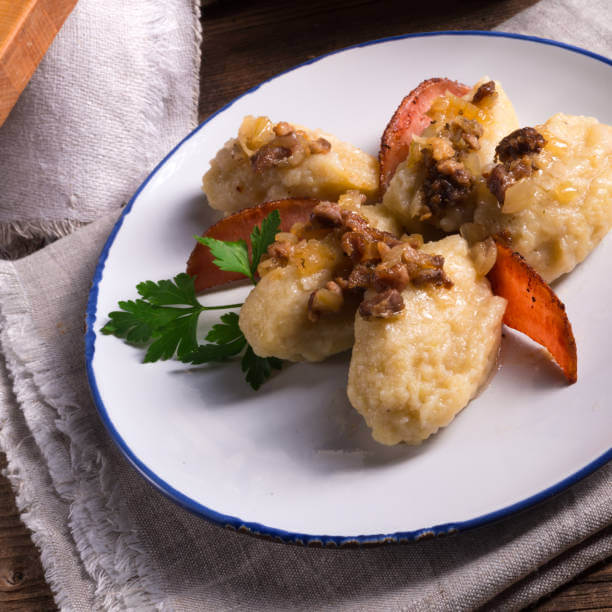
Lithuania
Cepelinai – Cepelinai (yes, named after the Zeppelin airship because of their shape) is a dish to have any Lithuanian smacking their lips on a cold winter evening. Cepelinai are thick potato dumplings – think lots of starch – filled with minced meat, mushrooms, curd cheese, or other fillings and topped with sour cream and bacon sauce. Once eaten, prepare for a nice relaxing nap by the fire.
Norway
Farikal – Keeping on the theme of comfort food, Norwegians love their Farikal — a simple but hearty stew of mutton and cabbage. The dish is so beloved in Norway that it even has its own (appropriately named) feast day on the last Thursday of September. The Farikal pursuits insist the dish is served with carrots, potatoes, cowberry sauce, and the obligatory flatbread.
Latvia
Grey peas and bacon – Wait! Before you run away yelling Yeuch, hear me out. The Latvian national dish is not only delicious but has also been recongnized in the Register of EU national products. You’re sure to find grey peas and bacon wherever you go in Latvia — everywhere! When the snow is chucking it down outside, there’s nothing quite like a steaming bowl of peas and back to put the glow back where it belongs.
If you want to take the stress out of your European explorations, online travel aggregators like Omio, G Adventures, DanCenter, and Holiday Autos can help you plan your trip, no matter your destination or your mode of transport.
Increase your purchasing power
Your hard earned money spent via Monetha’s app are worth more. Get rewarded with every purchase you make and redeem rewards to gift cards and cryptocurrency!
Ireland
Irish Stew – Let’s face it, Ireland isn’t especially known for it’s haute-cuisine, but it does have Irish Stew. And what a dish it is, especially when the rain is lashing the windows outside. A traditional Irish Stew is made with a slow-cooked (simmered) dish of tender lamb cuts — purists insist on neck meat — carrots, onions, parsnips, mushrooms, and of course potatoes. And don’t worry, it’s not a hanging offence to swap lamb for beef, and even add a wee drop of the black stuff, Guinness, if it takes your fancy.
Scotland
Haggis – Scotland’s national dish — “The great chieftain o’ the pudding race”, according to Scotland’s national poet, Robert Burns — Haggis tastes way better than it sounds. The Haggis is a boiled meat pudding made from a sheep’s heart, liver and lungs, mixed reverentially with salt, spices, suet, oatmeal and onion all stuffed inside the animal’s stomach lining. Served with tatties (potatoes) and neeps (turnips) Haggis is not for the faint-hearted, but the taste makes up for it in spades.

England
Fish and Chips – The jury is still out on this; roast beef and dumpling, bangers and mash, and even chicken tikka masala are all in the mix for the title of the country’s national dish. However, no visit to England is complete without a ‘trip down the chippy’ for the taste of freshly cooked fish and chips. Flavoured with salt and vinegar, fish and chips are best enjoyed with a sea breeze on your face.
Wales
Cawl – This ancient Welsh staple is lost in the depths of time, but it still holds pride of place on every Welsh table. A simple but hugely taste dish of meat broth cooked slowly over a turf fire (when available). For best results vegetables are added to the stock on the second day, or even the day after that. The meat for cawl is usually beef or lamb and is served with oatmeal dumplings. Simply delicious.
Iceland
Hákarl – It’s fair to say that if you’re not Icelandic you’re probably not going to like this one. How fermented shark ended up on the country’s menu is a story best told by an Icelander as you try your first taste — before gagging. OK, it’s not to my taste, but people still keep coming back for more. If you visit Iceland, take the challenge and try one of the weirdest national dishes on the planet.
Austria
Tafelspitz – OK, we could have gone for wiener schnitzel or apfelstrudel or even kaiserschmarrn, but instead we opted for Tafelspitz — sorry. However, there’s no denying that this boiled beef broth served with horseradish and carrots, spices and minced apples is a pure classic on the menu of every traditional Austrian restaurant. By the way, the dish changes slightly from region to region making it something you won’t get tired of if you’re traveling around.
Belgium
Waffles – No arguments, if it’s Belgium it’s got to be waffles. A Belgian icon, the humble crunchy, sugary waffle can be served however you like it. Whether bedecked by berries, bathing in butter, dripping with jam, or covered in cream, it’s your waffle, it’s your choice. Street food never tasted so sweet.
France
Pot-Au-Feu – The name might not drip off the tongue as easily as the taste, but France’s national dish comes with a long history. Literally translated as ‘pot on fire’ the dish is made from an assortment of meat cuts, super slow cooked with parsnip, turnips, white cabbage, onions, and the all important oxtail meat and bone marrow. Seasoned with black pepper, a bouquet garni, and cloves, this mish-mash of tastes is served with Dijon mustard and horseradish sauce. Ooooh la la!
Germany
Wurst – That’s right, we picked the easy way out, but Germany really does have a huge array of ‘national’ dishes to choose from. Schnitzels and pretzels, Rouladen and Kartoffelpuffer, Sauerbraten and Eintopf, but the common denominator across the whole country is Wurst — over 1,200 unique types of delicious sausages. From Blutwurst and Schwarzwurst to Currywurst and Weisswurst, if sausages bring out the ‘wurst’ in you, Germany is your culinary playground.
Netherlands
Stamppot – If a Netherlander ever finds themselves with too many potatoes in the larder the answer has got to be Stamppot. This simple winter classic dish is basic but delicious; potatoes mashed with kale, shallots, garlic, butter and milk, and topped with slices of traditional Dutch rookworst sausage (but you can use pretty much any sausage you can get your hands on). It may not be haute-cuisine, but it sure is mighty tasty.
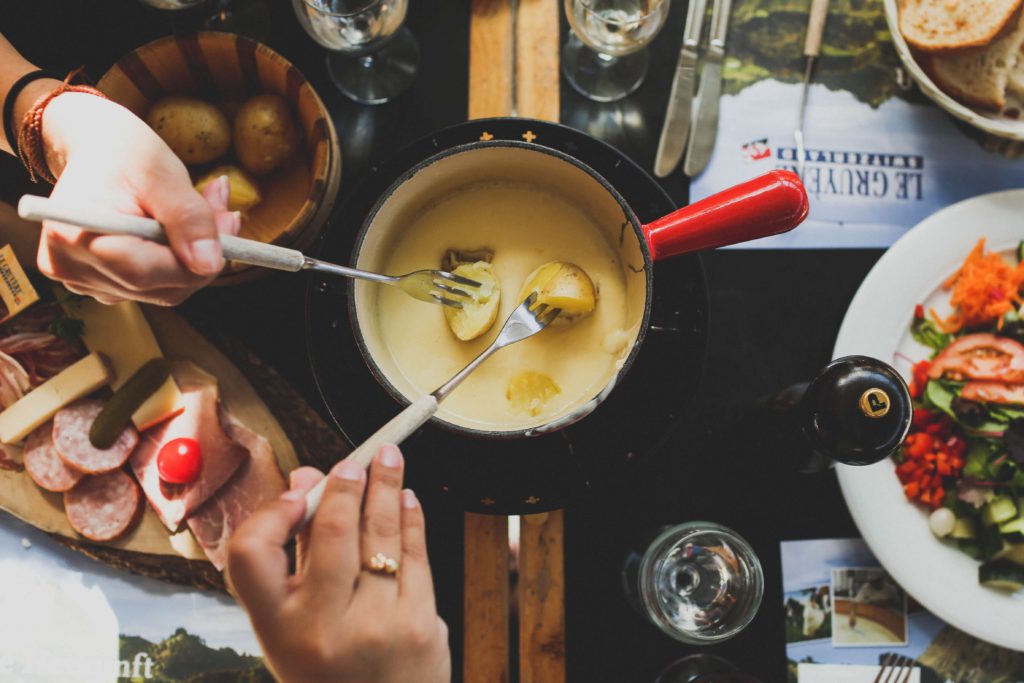
Switzerland
Fondue – Nothing screams dinner party in Switzerland quite like a good old fashioned fondue. Fondue is typically a big brass pot of super creamy melted cheese for dipping meats, bread, potatoes, or anything else you might fancy. A centre piece to any Swiss meal, fondue — and a couple of beers — gets the conversation flowing quicker than you can say Alpenhorn.
Bulgaria
Shopska salad – Having a salad as a national dish is quite unusual, but apparently Bulgaria wasn’t listening. Shopska salad is a national staple created from a mixture of cucumbers, diced tomatoes, onions, and peppers topped with either sirene or feta cheese and a sprinkling of parsley. Interestingly, the colors of Shopska Salad, red, white, and green, also make up the colors of the Bulgarian flag. A dish doesn’t get much more national than that.
Czech Republic
Vepřo knedlo zelo – This meaty Czech stable is easily found on every menu from Prague to Pilsen, but not so easy to pronounce. For a dish that sounds as complicated as a Smetana concerto, the opposite is true. Combine roasted pork with simple bread dumplings and pickled cabbage and you’re ready to go. However, as it’s the Czech Republic, no meal, no matter what it’s called, is complete without a glass of delicious local beer. Na zdraví!
Hungary
Goulash – It’s that simple, Hungarians love goulash. For the uninitiated, goulash is a hearty stew made from beef, vegetables, bell peppers, tomatoes and doused with generous portions of paprika – very generous portions. The Hungarian staple is usually accompanied by small butter noodles call csipetke, or mashed potatoes, or dumplings, or rice, or anything that mops up that deliciously warm peppery sauce.
Moldova
Mamaliga – Moldova generally flies under the radar of most tourists, but if this small slice of loveliness is on your travel itinerary, Mamaliga should also feature highly. Located at the crossroads of Europe and Asia, the country is bountiful in its food choices. Mamaliga is a type of cornmeal porridge that is part of every Moldovan’s recipe book and is never hard to find. But don’t worry, if you visit Moldova, a bit like Chuck Norris, Mamaliga will find you.
Poland
Bigos Stew – Bigos or Pierogi, Bigos or Pierogi? Ok, we have to pick just one Polish national dish so it’s got to be Bigos Stew. Also known as Hunter’s Stew, Bigos can be made using any type of meat you choose mixed with cabbage, mushrooms, and smoked sausage. This hearty winter favorite dates back as far as the 14th century and is still as popular today as it was with both the peasants and the nobility alike back in the day.
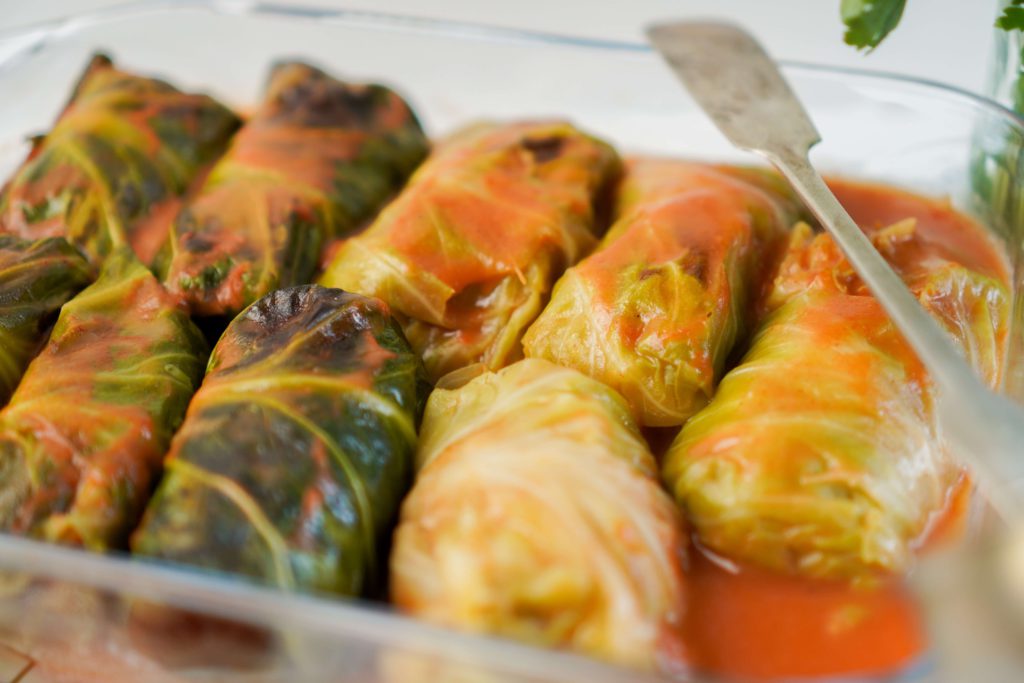
Romania
Sarmale – Cabbage rolls exist in one form or another across much of eastern Europe. But for my two cents, none of them even come close to Romanian Sarmale. The secret behind great Romanian Sarmale is the use of sour cabbage and smoked meat, usually bacon. Every family’s recipe is usually handed down through the generations, making the owner prouder than a peacock in a room full of turkey buzzards.
Slovakia
Bryndzové Halušky – The first time someone serves you Bryndzové Halušky it might come as a bit of a shock. Its appearance can be a little… off-putting. However, if you put your fears to one side, this Slovkian favorite, consisting of boiled potato dough sprinkled with bacon or smoked pork fat and chives can be quite delicious. A small note of warning — the meal is usually served with Žinčica, a type of sheep’s milk whey; sadly, that’s usually where I draw the line.
Increase your purchasing power
Your hard earned money spent via Monetha’s app are worth more. Get rewarded with every purchase you make and redeem rewards to gift cards and cryptocurrency!
Serbia
Pljeskavica – What might look like a humble hamburger, unusually served in a pitta bread, will have you coming back for more and more. Found in both restaurants and for sale by street vendors, Pljeskavica is made from a mixture of beef, pork, and lamb and can even come in a sausage format — much like the ćevapčići of Serbia’s neighboring countries. If you’re going for a beer with friends in Belgrade, Pljeskavica will never be far away.
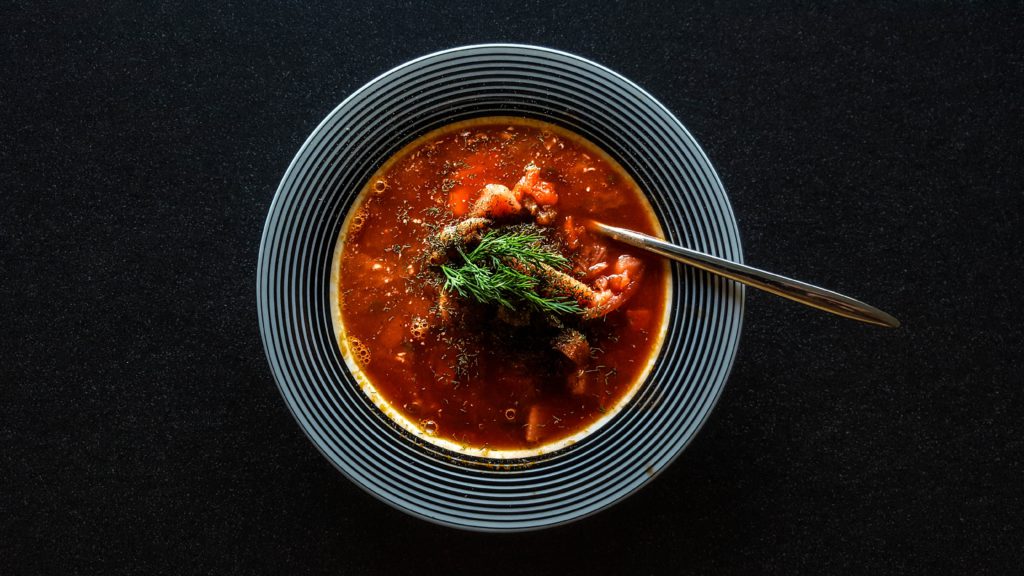
Ukraine
Borscht – There can be no compromise, Borscht, a flavorsome red soup made from beets, onions, and meat, rules the Ukrainian kitchen. Although the consistency, along with some ingredients, may change from family to family or region to region, Borscht is the stuff of Ukrainian legend. As I once heard it described by a Ukrainian emigrant, “A big bowl of Ukrainian nostalgia’. A dish doesn’t get a better accolade than that.
Croatia
Zagorski Štrukli – Croatia is a geographic mix of mountains, meadows, coastline, and islands, meaning the country’s national foods can change from one place to the next. However, if you had to pick one truly Croatian dish, it would have to be Zagorski Štrukli, a traditional pastry dish that can be either sweet or savory. Depending on where you go in Croatia, or even the time of day, your Zagorski Štrukli can be either your main course or your dessert.
Bosnia Herzegovina
Cevapi – Similar to the earlier mentioned Pljeskavica, the Cevapi of Bosnia Herzegovina come in sausage form and are served in pitta bread with a side of chopped onion. The Cevapi can be made using beef, veal, pork or lamb, but regardless of the actual meat used the taste is delicious – especially when cooked over an open-flame grill. Whatever you do, never compare Cevapi with similar types of food from neighboring countries. Cevapi are Cevapi.

Greece
Gyros – We could have chosen Moussaka, Fasolada, or Gryos, but to be honest, there was no competition. Gyros — pronounced Yee-ros — is similar to (never say the same as) kebabs, and are made from succulent spit-roasted meat (chicken or pork) cradled in pitta bread, adorned with crispy salad and tzatziki sauce. Available on every street corner in Athens, this is the perfect fast snack for wanderers who like to eat cheaply while on the go. If you’ve never tasted Gyros, your first bite is sure to be a symphony for the taste buds.
Italy
Ragu alla Bolognese – No, Italy’s national dish is NOT pizza (as much as we all love it). Ragu alla Bolognese, or simply, Bolognese is popular throughout all of Italy. To put it simply, (never say this to an Italian grandmother) Bolognese is simply a meat-based sauce — either minced beef, pork, or veal — braised with carrots, onions, butter, and pancetta and served with the pasta of your choice. Although the dish is a national treasure, its fame has also grown right around the world.
Portugal
Bacalhau – Dried salted codfish, or Bacalhau, is as much a part of Portugal as fado and football. It is often said that there are 365 different recipes for Bacalhau, one for every day of the year. If the truth is known, there are probably far more variations from family to family, region to region, and restaurant to restaurant. Usually, the dried Bacalhau is soaked in water or milk prior to the next stage in the cooking process and is an intrinsic part of Portuguese history. Back in the 16th century, huge fleets of boats left Portugal for the bountiful, and dangerous cod fishing grounds of Newfoundland. These boats, and their crews were often away for 6 months at a time and culminated in huge Bacalhau festivals on their safe return.
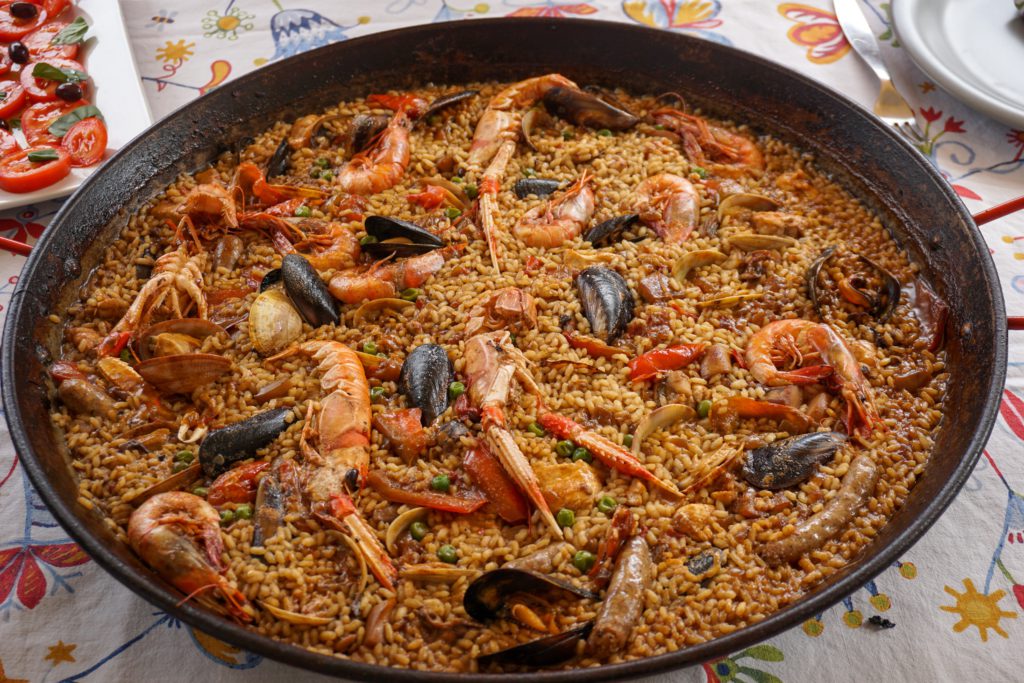
Spain
Paella – It’s fair to say that every region of Spain has its own ‘National’ dish. However, Paella is the one dish that unites the entire country. Across the country, the rice-and saffron-based dish has multiple variations, although in its original form Paella was a seafood-based dish that originated in and around Valencia. Since then, the dish has evolved to contain rabbit, duck, chicken, chorizo, and other meats. Cooked in a flat two-handled pan, the dish is both a feast for the eyes and the stomach.
Slovenia
Struklj – Because of it geographic location, Slovenia stands at a culinary crossroads. Influenced by Mediterranean, Alpine, and Slavic cuisine, the country’s residents are often at loggerheads over their national dish. That’s why we’ve decided on Struklj, large rolls of buckwheat pastry filled with a variety of cheeses. For sweet varieties, the Struklj are filled with cottage cheese, nuts, and berries. For those who like their Struklj on the salty side, the dough can be filled with an assortment of savory cheeses flavored with tarragon and other spices.
Malta
Stuffat Tal-Fenek – If it’s Malta, it’s got to have rabbits. Stuffat Tal-Fenek is a rabbit stew synonymous with the Mediterranean island. But it wasn’t always like that. Rabbits were introduced to the islands by the Phoenicians to ensure a constant supply of fresh meat. Eventually, rabbits did what rabbits do the world over and multiplied, making rabbit meat cheap and easily accessable, and Stuffat Tal-Fenek the national dish until this day.
Cyprus
Halloumi – Like Batman and Robin or Enkidou and Gilgamesh, Halloumi and Cyprus go hand in hand. Holloumi is a soft white cheese made from either goat’s or sheep’s milk and is equally enjoyed paired with quality wines or fresh fruits. Usually served as a starter in local restaurants and taverns, Halloumi can be eaten raw or sear-grilled on a pan. Everywhere you go in Cyprus, the fat-rich cheese is enjoyed with the fruits of the land, olives, bread, almonds, apricots, or anything else seasonal that comes to hand.
Turkey
Baklava – Sweet, sweet, sweet, that’s Baklava, the Turkish national treasure. Steeped in history, and dating back to the Ottoman Empire, Baklava has become an icon of Turkish cuisine and confection. Made from layers of pastry piled with a rich filling of nuts covered in syrup and topped with pistachios, Baklava truly is the sweet taste of the Mediterranean.
Some of the best food in Europe
We might not have gotten the exact national dish right, but hopefully we’ve started a conversation. And let’s face it, everyone loves talking about food — then eating it. Even if we got the national dishes wrong, hopefully we’ve introduced you some new tastes and new flavors to explore on your travels through Europe.
And as you travel, try to remember the words of restaurateur Guy Fieri.
“Cooking is all about people. Food is maybe the only universal thing that really has the power to bring everyone together. No matter what culture, everywhere around the world, people eat together.”
Bon voyage, et bon appétit!
ready? Here's your welcome bonus!
Sign up to Monetha’s app and get a welcome bonus of 2000 points to start your earnings journey!

 Photo by
Photo by 


